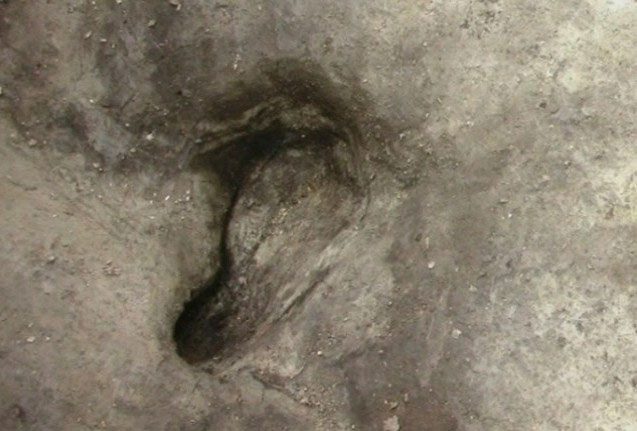According to Science Alert, ancient footprints from 300,000 years ago belonging to Homo heidelbergensis indicate that these early humans lived around shallow lakes and rivers.
Specifically, researchers discovered examples of human footprints in Germany. Dating back approximately 300,000 years, the researchers believe that these footprints were not made by Homo sapiens but were formed by the now-extinct Homo heidelbergensis.

One of the footprints described in the study. (Photo: Senckenberg).
The Significance of Discovering Human Footprints
These impressions provide researchers with a vivid insight into the lifestyle of early humans. Additionally, they were found alongside animal footprints at the Old Stone Age site of Schöningen in Lower Saxony, northwestern Germany.
Homo heidelbergensis were skilled hunters, and their ancestors date back even further than the Neanderthals. In fact, they are considered the last common ancestors of both Neanderthals and modern humans.
“For the first time, we conducted a detailed study of fossilized footprints from two sites in Schöningen,” said archaeologist Flavio Altamura from the University of Tübingen in Germany.
Altamura noted that these traces, combined with information from sediment analyses, archaeology, paleontology, and paleobotany, provided extensive insights into the ancient environment and the mammals that once inhabited the area.
Based on research and examination of the sediment layers and preserved bones at the site, scientists concluded that this was a lake surrounded by lush scenery with many rows of birch, pine trees, and grasses.
Only 3 Homo heidelbergensis footprints were identified, which did not provide much information for researchers. However, by comparing with observations from other studies, the team estimates that these 3 footprints were made by one adult and two juveniles, likely indicating a family outing. The surrounding environment showed ample evidence that elephants, rhinoceroses, and even-toed ungulates frequently visited the lake, all of which utilized the water for bathing or drinking.
“Depending on the season, trees, fruits, leaves, buds, and mushrooms would appear around the lake. Our findings confirm that extinct humans lived by lakes or rivers with shallow water. This is similar to other sites from the Late and Middle Pleistocene with human footprints,” Altamura stated.

Reconstruction of the Heidelberg human habitat. (Photo: Benoît Clarys).
Unlocking the Potential of Technology
According to scientists, beneath the sediment layers at this site, there is also a significant amount of well-preserved wooden tools, providing further details about how the ancestors of Homo heidelbergensis operated. While it is difficult to ascertain how these tools were used 300,000 years ago, they could have been utilized for hunting, harvesting, or construction.
Additionally, evidence of the extinct elephant species Palaeoloxodon antiquus was found at the research site. This elephant could stand up to 4.2 meters tall and weigh 13 tons. Furthermore, a rhinoceros footprint, the first of its kind discovered in Europe, was also identified.
The aforementioned discoveries represent a treasure trove in an area renowned for preserving the history of ancient humanity. They illustrate the potential of technology, studying the traces left behind from human footprints to animal caves.
“Technological studies are emerging as a powerful tool for reconstructing environmental, ecological, and archaeological landscapes. They offer high-resolution insights into prehistoric sites, particularly when integrated as a multidisciplinary approach,” the researchers wrote in a paper published in the journal Quaternary Science Reviews.


















































